
Actividades para trabajar las diferentes tortugas con alumnos de educación infantil.
- Subject:
- Biology
- Life Science
- Material Type:
- Diagram/Illustration
- Lesson
- Author:
- Maria Perez
- Date Added:
- 06/19/2023

Actividades para trabajar las diferentes tortugas con alumnos de educación infantil.
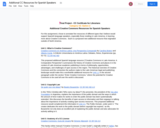
An annotated list of resources of different types to support Spanish-language speakers in learning more about Creative Commons.

El objeto de aprendizaje Quizizz va dirigido a los estudiantes que cursan el primer grado de educación primaria que se encuentran en una edad entre 6 y 7 años de edad. Basado en el conteo y serie de diez en diez del tema de las decenas..

Presento una lección sobre Estructura Organizacional, basada en los recursos humanos, con una actividad para complementar el contenido.

Software created by the Eylbid Strategic Partnership co-financed by the Erasmus+ program of the European Union (agreement no. 2019-1-ES01-KA201-064417). This video game can be used as a classroom activity with the following objectives:
to show that language brokering is a common practice that takes place in many schools around the world;
to promote a deeper understanding of what language brokering usually implies for young people;
to present some situations that teachers can analyze and discuss with their students from multiple perspectives as part of reflective practice;
to appreciate multilingualism and raise awareness among young people who translate and interpret in schools;
to provide young language brokers with tools and strategies to express how they feel about language brokering, and thus to take care of emotional health.
The videogame is multilingual and can be played in English, Catalan, German, Italian, and Spanish.
***
Programari creat per l'Associació Estratègica Eylbid cofinançada pel programa Erasmus+ de la Unió Europea (acord núm. 2019-1-ES01-KA201-064417). Es tracta d'un videojoc pensat perquè es faci servir com a activitat d'aula amb els objectius següents:
mostrar que la intermediació lingüística és una pràctica comuna que es duu a terme a moltes escoles arreu del món;
promoure una comprensió més profunda del que sol implicar la intermediació lingüística per part dels joves;
presentar algunes situacions que els docents puguin analitzar i discutir amb els seus alumnes des de múltiples perspectives com a part de la pràctica reflexiva;
apreciar el plurilingüisme i sensibilitzar els joves que tradueixen i interpreten a les escoles;
proporcionar als joves intermediaris lingüístics eines i estratègies per expressar com se senten en relació amb la intermediació lingüística i per tenir cura de la salut emocional.
El videojoc té diverses llengües disponibles: alemany, anglès, català, castellà i italià.
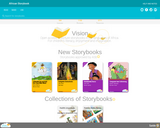
The African Storybook (ASb) is a literacy initiative that provides openly licensed picture storybooks for early reading in the languages of Africa. Developed and hosted by Saide, the ASb has an interactive website that enables users to read, create, download, translate, and adapt stories. The initiative addresses the dire shortage of children’s storybooks in African languages, crucial for children’s literacy development.

Agricultural Connections is a middle school curricular program framework created by EarthGen. For this unit, we offer professional development training and assistance with implementation. Please let us know if you are interested in implementing this program at your school or district! Please contact info@earthgenwa.org for more information.

Esta es una lección virtual acerca del procedimiento para obtener los parámetros de Margules a partir de los datos experimentales de un equilibrio líquido vapor
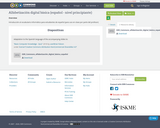
Introducción al vocabulario informático para estudiantes de español (para uso en clase por parte del profesor)
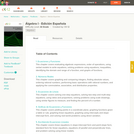
CK-12 Foundation's Algebra FlexBook is an introduction to algebraic concepts for the high school student. Topics include: Equations & Functions, Real Numbers, Equations of Lines, Solving Systems of Equations & Quadratic Equations.

(Nota: Esta es una traducción de un recurso educativo abierto creado por el Departamento de Educación del Estado de Nueva York (NYSED) como parte del proyecto "EngageNY" en 2013. Aunque el recurso real fue traducido por personas, la siguiente descripción se tradujo del inglés original usando Google Translate para ayudar a los usuarios potenciales a decidir si se adapta a sus necesidades y puede contener errores gramaticales o lingüísticos. La descripción original en inglés también se proporciona a continuación.)
"Los estudiantes conectan la aritmética polinomial con los cálculos con números enteros e enteros. Los estudiantes aprenden que la aritmética de las expresiones racionales se rige por las mismas reglas que la aritmética de los números racionales. Esta unidad ayuda a los estudiantes a ver conexiones entre soluciones a ecuaciones polinomiales, ceros de polinomiales,, y gráficos de funciones polinómicas. Las ecuaciones polinomiales se resuelven sobre el conjunto de números complejos, lo que lleva a una comprensión inicial del teorema fundamental del álgebra. Los problemas de aplicación y modelado conectan múltiples representaciones e incluyen situaciones de mundo real y puramente matemáticas.
Encuentre el resto de los recursos matemáticos de Engageny en https://archive.org/details/engageny-mathematics.
English Description:
"Students connect polynomial arithmetic to computations with whole numbers and integers. Students learn that the arithmetic of rational expressions is governed by the same rules as the arithmetic of rational numbers. This unit helps students see connections between solutions to polynomial equations, zeros of polynomials, and graphs of polynomial functions. Polynomial equations are solved over the set of complex numbers, leading to a beginning understanding of the fundamental theorem of algebra. Application and modeling problems connect multiple representations and include both real world and purely mathematical situations.
Find the rest of the EngageNY Mathematics resources at https://archive.org/details/engageny-mathematics.

(Nota: Esta es una traducción de un recurso educativo abierto creado por el Departamento de Educación del Estado de Nueva York (NYSED) como parte del proyecto "EngageNY" en 2013. Aunque el recurso real fue traducido por personas, la siguiente descripción se tradujo del inglés original usando Google Translate para ayudar a los usuarios potenciales a decidir si se adapta a sus necesidades y puede contener errores gramaticales o lingüísticos. La descripción original en inglés también se proporciona a continuación.)
"En este módulo, los estudiantes sintetizan y generalizan lo que han aprendido sobre una variedad de familias de funciones. Extienden el dominio de las funciones exponenciales a toda la línea real (n-rn.a.1) y luego extienden su trabajo con estas funciones a incluir la resolución de ecuaciones exponenciales con logaritmos (F-le.a.4). Exploran (con herramientas apropiadas) los efectos de las transformaciones en gráficos de funciones exponenciales y logarítmicas. Notan que las transformaciones en un gráfico de una función logarítmica se relacionan con el Propiedades logarítmicas (F-BF.B.3). Los estudiantes identifican tipos apropiados de funciones para modelar una situación. Ajustan los parámetros para mejorar el modelo y comparan los modelos analizando la idoneidad del ajuste y las juicios sobre el dominio sobre el cual un modelo es un buen ajuste. La descripción del modelado como, el proceso de elegir y usar matemáticas y estadísticas para analizar situaciones empíricas, comprenderlas mejor y tomar decisiones, está en el corazón de este módulo. En particular, a través de oportunidades repetidas para trabajar a través del ciclo de modelado (consulte la página 61 del CCLS), los estudiantes adquieren la idea de que la misma estructura matemática o estadística a veces puede modelar situaciones aparentemente diferentes.
Encuentre el resto de los recursos matemáticos de Engageny en https://archive.org/details/engageny-mathematics ".
English Description:
"In this module, students synthesize and generalize what they have learned about a variety of function families. They extend the domain of exponential functions to the entire real line (N-RN.A.1) and then extend their work with these functions to include solving exponential equations with logarithms (F-LE.A.4). They explore (with appropriate tools) the effects of transformations on graphs of exponential and logarithmic functions. They notice that the transformations on a graph of a logarithmic function relate to the logarithmic properties (F-BF.B.3). Students identify appropriate types of functions to model a situation. They adjust parameters to improve the model, and they compare models by analyzing appropriateness of fit and making judgments about the domain over which a model is a good fit. The description of modeling as, the process of choosing and using mathematics and statistics to analyze empirical situations, to understand them better, and to make decisions, is at the heart of this module. In particular, through repeated opportunities in working through the modeling cycle (see page 61 of the CCLS), students acquire the insight that the same mathematical or statistical structure can sometimes model seemingly different situations.
Find the rest of the EngageNY Mathematics resources at https://archive.org/details/engageny-mathematics."

(Nota: Esta es una traducción de un recurso educativo abierto creado por el Departamento de Educación del Estado de Nueva York (NYSED) como parte del proyecto "EngageNY" en 2013. Aunque el recurso real fue traducido por personas, la siguiente descripción se tradujo del inglés original usando Google Translate para ayudar a los usuarios potenciales a decidir si se adapta a sus necesidades y puede contener errores gramaticales o lingüísticos. La descripción original en inglés también se proporciona a continuación.)
Los estudiantes crean una comprensión formal de la probabilidad, considerando eventos complejos como sindicatos, intersecciones y complementos, así como el concepto de independencia y probabilidad condicional. La idea de usar una curva suave para modelar una distribución de datos se introduce junto con el uso de tablas y tecnología para encontrar áreas bajo una curva normal. Los estudiantes hacen inferencias y justifican conclusiones de encuestas de muestra, experimentos y estudios de observación. Los datos se usan de muestras aleatorias para estimar una media o proporción de población. Los estudiantes calculan el margen de error y lo interpretan en contexto. Dados los datos de un experimento estadístico, los estudiantes usan la simulación para crear una distribución de aleatorización y lo usan para determinar si hay una diferencia significativa entre dos tratamientos.
Encuentre el resto de los recursos matemáticos de Engageny en https://archive.org/details/engageny-mathematics.
English Description:
Students build a formal understanding of probability, considering complex events such as unions, intersections, and complements as well as the concept of independence and conditional probability. The idea of using a smooth curve to model a data distribution is introduced along with using tables and technology to find areas under a normal curve. Students make inferences and justify conclusions from sample surveys, experiments, and observational studies. Data is used from random samples to estimate a population mean or proportion. Students calculate margin of error and interpret it in context. Given data from a statistical experiment, students use simulation to create a randomization distribution and use it to determine if there is a significant difference between two treatments.
Find the rest of the EngageNY Mathematics resources at https://archive.org/details/engageny-mathematics.

(Nota: Esta es una traducción de un recurso educativo abierto creado por el Departamento de Educación del Estado de Nueva York (NYSED) como parte del proyecto "EngageNY" en 2013. Aunque el recurso real fue traducido por personas, la siguiente descripción se tradujo del inglés original usando Google Translate para ayudar a los usuarios potenciales a decidir si se adapta a sus necesidades y puede contener errores gramaticales o lingüísticos. La descripción original en inglés también se proporciona a continuación.)
En calificaciones anteriores, los estudiantes definen, evalúan y comparan las funciones y las usan para modelar las relaciones entre las cantidades. En este módulo, los estudiantes extienden su estudio de funciones para incluir la notación de la función y los conceptos de dominio y rango. Exploran muchos ejemplos de funciones y sus gráficos, centrándose en el contraste entre las funciones lineales y exponenciales. Interpretan funciones dadas gráfica, numérica, simbólica y verbalmente; traducir entre representaciones; y comprender las limitaciones de varias representaciones.
Encuentre el resto de los recursos matemáticos de Engageny en https://archive.org/details/engageny-mathematics.
English Description:
In earlier grades, students define, evaluate, and compare functions and use them to model relationships between quantities. In this module, students extend their study of functions to include function notation and the concepts of domain and range. They explore many examples of functions and their graphs, focusing on the contrast between linear and exponential functions. They interpret functions given graphically, numerically, symbolically, and verbally; translate between representations; and understand the limitations of various representations.
Find the rest of the EngageNY Mathematics resources at https://archive.org/details/engageny-mathematics.

(Nota: Esta es una traducción de un recurso educativo abierto creado por el Departamento de Educación del Estado de Nueva York (NYSED) como parte del proyecto "EngageNY" en 2013. Aunque el recurso real fue traducido por personas, la siguiente descripción se tradujo del inglés original usando Google Translate para ayudar a los usuarios potenciales a decidir si se adapta a sus necesidades y puede contener errores gramaticales o lingüísticos. La descripción original en inglés también se proporciona a continuación.)
En módulos anteriores, los estudiantes analizan el proceso de resolver ecuaciones y desarrollar fluidez en la escritura, interpretación y traducción entre varias formas de ecuaciones lineales (Módulo 1) y funciones lineales y exponenciales (Módulo 3). Estas experiencias combinadas con el modelado con datos (Módulo 2), preparan el escenario para el módulo 4. Aquí los estudiantes continúan interpretando expresiones, crean ecuaciones, reescriben ecuaciones y funciones en formas diferentes pero equivalentes, y gráficos e interpretan funciones, pero esta vez utilizando polinomial funciones y funciones más específicamente cuadráticas, así como funciones de raíz de raíz cuadrada y de cubos.
Encuentre el resto de los recursos matemáticos de Engageny en https://archive.org/details/engageny-mathematics.
English Description:
In earlier modules, students analyze the process of solving equations and developing fluency in writing, interpreting, and translating between various forms of linear equations (Module 1) and linear and exponential functions (Module 3). These experiences combined with modeling with data (Module 2), set the stage for Module 4. Here students continue to interpret expressions, create equations, rewrite equations and functions in different but equivalent forms, and graph and interpret functions, but this time using polynomial functions, and more specifically quadratic functions, as well as square root and cube root functions.
Find the rest of the EngageNY Mathematics resources at https://archive.org/details/engageny-mathematics.

Es una página web que contiene un video sobre la historia de Alicia quien vive estereotipos de género durante la escuela. El fin de este recurso es hacer consciencia y lograr un cambio en los roles de género que se les otorgan a las niñas y niños.
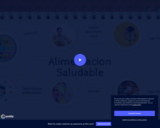
Breve explicación y consejos para una alimentación saludable
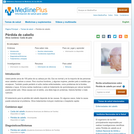
This health education program explains alopecia including the different types of hair loss, the causes, and the treatment options. It also reviews normal hair growth. This resource is a MedlinePlus Interactive Health Tutorial from the National Library of Medicine, designed and developed by the Patient Education Institute.

Watch alpha particles escape from a polonium nucleus, causing radioactive alpha decay. See how random decay times relate to the half life.

Los estudiantes aprenden acerca de la electricidad y el magnetismo mediante la construcción de altavoces